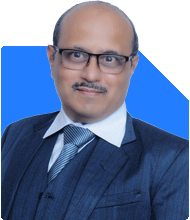I'm 46 with a family – Can I retire within a year?
Ramalingam Kalirajan |10893 Answers |Ask -Follow
Mutual Funds, Financial Planning Expert - Answered on Jan 28, 2025
He has an MBA in finance from the University of Madras and is a certified financial planner.
He is the director and chief financial planner at Holistic Investment, a Chennai-based firm that offers financial planning and wealth management advice.... more

I AM 46 YEAR OLOD WITH 42 YEARS OLD WIFE AND 2 KIDS AGED 12 & 7.I HAVE CORPUS OF ABOUT 1.7CR IN PF,30 L IN NPS , 75L IN PPF,40L INMFS AND 40 LAKHS IN FDS.I AHVE MY OWN HOME IN TIER 2 CITY.CAN I RETIRE WITHIN A YEAR.
Your corpus is Rs. 3.55 crore, spread across various investment options.
PF (Rs. 1.7 crore) offers security and regular income post-retirement.
NPS (Rs. 30 lakh) provides a partial annuity option, though withdrawal rules apply.
PPF (Rs. 75 lakh) is risk-free with tax-free returns but has liquidity restrictions.
Mutual funds (Rs. 40 lakh) give growth potential but are market-linked.
FDs (Rs. 40 lakh) provide stability but may not beat inflation.
You own a home, which secures your housing needs.
Your spouse (42 years) and kids (12 and 7 years) add ongoing financial responsibilities.
Is Retirement Feasible Within a Year?
Retiring at 46 is achievable but depends on expense control and inflation.
Your corpus can support early retirement with disciplined investment.
Children's education and healthcare costs are key considerations.
Planning for Children’s Education
Higher education costs will increase significantly in the next 5-10 years.
Allocate separate funds for this goal in debt or balanced instruments.
Use PPF maturity or part of FDs for these expenses.
Creating an Emergency Fund
Set aside 12-18 months of expenses as an emergency fund (Rs. 6-9 lakh).
Liquid funds or high-interest savings accounts are ideal for emergencies.
This provides financial security during unforeseen events.
Insurance Coverage Assessment
Ensure adequate health insurance for your family, including top-up plans.
Consider health coverage of at least Rs. 20-25 lakh for medical emergencies.
Reassess life insurance for you and your spouse post-retirement.
Addressing Inflation
Inflation will erode your purchasing power over the years.
Allocate a portion of your corpus to equity mutual funds for growth.
Balanced investment ensures long-term financial stability.
Asset Allocation Strategy Post-Retirement
Equity Allocation
Invest 40%-45% in equity mutual funds for inflation-beating returns.
Choose actively managed large-cap or flexi-cap funds for moderate risk.
Avoid sector-specific or small-cap funds at this stage.
Debt Allocation
Keep 40%-45% in debt instruments like PPF, debt funds, and SCSS.
Debt funds offer better post-tax returns than FDs.
Use staggered withdrawals from PPF to fund expenses.
Gold Allocation
Maintain gold allocation through SGB or gold ETFs if needed.
Avoid increasing allocation as it doesn’t generate income.
Liquid Assets
Keep 5%-10% of your portfolio in liquid funds or savings accounts.
This ensures liquidity for short-term needs.
Generating Regular Income
Systematic Withdrawal Plans (SWP)
Use SWPs from mutual funds for tax-efficient monthly income.
Start with a 3%-4% annual withdrawal rate.
Reinvest unspent amounts to preserve corpus.
Laddered Fixed Deposits
Use laddered FDs for periodic and predictable cash flows.
Avoid reinvesting in FDs during low-interest rate cycles.
Senior Citizen Savings Scheme (SCSS)
SCSS offers stable returns but is taxable.
Invest within limits to balance stability and tax efficiency.
Tax Planning
Equity mutual funds’ LTCG above Rs. 1.25 lakh is taxed at 12.5%.
STCG on equity funds is taxed at 20%.
Debt mutual funds’ LTCG and STCG are taxed as per your tax slab.
Plan withdrawals carefully to minimise tax liability.
LIC and Investment Plans
If you hold LIC or investment-linked insurance, review its returns.
Surrender low-performing plans and reinvest in mutual funds for higher growth.
Consult a Certified Financial Planner for a detailed assessment.
Steps to Minimise Risks
Diversify across asset classes to reduce dependency on any one investment.
Review your portfolio annually to maintain balance.
Avoid emotional decision-making during market fluctuations.
Long-Term Financial Monitoring
Regularly review your spending to ensure it aligns with your plan.
Adjust your asset allocation based on lifestyle changes and market performance.
Seek guidance from a Certified Financial Planner for timely updates.
Final Insights
Your current corpus can support early retirement with efficient planning. Allocate funds wisely for children’s education and inflation. Build a diversified portfolio to ensure growth and stability. Prioritise regular income generation and tax efficiency.
Best Regards,
K. Ramalingam, MBA, CFP,
Chief Financial Planner,
www.holisticinvestment.in
https://www.youtube.com/@HolisticInvestment
You may like to see similar questions and answers below
Milind Vadjikar | Answer |Ask -Follow
Insurance, Stocks, MF, PF Expert - Answered on Jan 26, 2025
Ramalingam Kalirajan |10893 Answers |Ask -Follow
Mutual Funds, Financial Planning Expert - Answered on Feb 04, 2025
Ramalingam Kalirajan |10893 Answers |Ask -Follow
Mutual Funds, Financial Planning Expert - Answered on Jan 28, 2025
Ramalingam Kalirajan |10893 Answers |Ask -Follow
Mutual Funds, Financial Planning Expert - Answered on Apr 07, 2025
Nitin Narkhede |113 Answers |Ask -Follow
MF, PF Expert - Answered on Dec 15, 2025
Nitin Narkhede |113 Answers |Ask -Follow
MF, PF Expert - Answered on Dec 15, 2025
Ramalingam Kalirajan |10893 Answers |Ask -Follow
Mutual Funds, Financial Planning Expert - Answered on Dec 15, 2025
Ramalingam Kalirajan |10893 Answers |Ask -Follow
Mutual Funds, Financial Planning Expert - Answered on Dec 15, 2025
Radheshyam Zanwar |6746 Answers |Ask -Follow
MHT-CET, IIT-JEE, NEET-UG Expert - Answered on Dec 15, 2025
Ramalingam Kalirajan |10893 Answers |Ask -Follow
Mutual Funds, Financial Planning Expert - Answered on Dec 15, 2025
Ramalingam Kalirajan |10893 Answers |Ask -Follow
Mutual Funds, Financial Planning Expert - Answered on Dec 15, 2025
Ramalingam Kalirajan |10893 Answers |Ask -Follow
Mutual Funds, Financial Planning Expert - Answered on Dec 15, 2025
Samraat Jadhav |2508 Answers |Ask -Follow
Stock Market Expert - Answered on Dec 15, 2025
Ramalingam Kalirajan |10893 Answers |Ask -Follow
Mutual Funds, Financial Planning Expert - Answered on Dec 15, 2025























